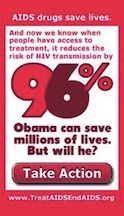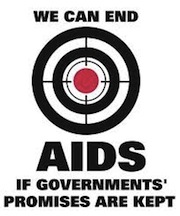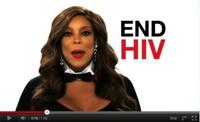 My generation stepped up to fight an epidemic that nobody cared about. We’ve endured the loss of countless friends and lovers.
My generation stepped up to fight an epidemic that nobody cared about. We’ve endured the loss of countless friends and lovers. On World AIDS Day 2011, we can change the narrative of loss to one of victory.
The first 15 years of our movement were mired in sickness and death. In 1996, Protease Inhibitors changed this so that the next 15 years were about living with the virus and trying to stop new infections. Let’s mark this World AIDS Day as the beginning of the end!
As Secretary of State Hillary Clinton said this month, we can have an AIDS-free generation. HIV Prevention Trials Network (HPTN) study 052 proved that starting HIV-positive individuals in a treatment regimen early and suppressing their viral load to undetectable poses no harm and can cut the risk of HIV transmission by as much as 96 percent.
Now we must take the science of 052 and make it work in the real world, to implement Treatment as Prevention (TasP). We have the knowledge, but do we have the money and the political will to end this epidemic?
 NMAC’s Big Audacious Goal: To Help 600,000 HIV Positive
NMAC’s Big Audacious Goal: To Help 600,000 HIV PositiveAmericans Achieve an Undetectable Viral Load
Dr. Julio Montaner said at United States Conference on AIDS (USCA) that we need at least 50% of People with AIDS (PWAs) in the U.S. to be virally suppressed in order to see the benefits of TasP. He says it will take 50 years, let’s try to do it in 25. What are you doing for the next 25 years? Can you think of a better way to spend your time?
New Mission
At this year’s USCA, NMAC’s board released our new mission: to develop leadership within communities of color to end the HIV/AIDS epidemic.
Is it time to review your mission?
Our movement is changing. Many questions remain in terms of the full implementation of the Patient Protection and Affordable Care Act (ACA), National HIV/AIDS Strategy (NHAS), High Impact Prevention (HIP), and the reauthorization of the Ryan White CARE Act (RWCA). NMAC’s new mission gives a new context for our work. Implementation of these programs is now viewed in the context of how they will help end the epidemic.
The Current Epidemic
According to a new CDC report released Tuesday “Vital Signs: HIV Prevention Through Care and Treatment” there remains much work remains to be done. While there are 1.2 million individuals living with HIV in America, only about 328,475, or 28% have undetectable viral loads. That means we need to get at least another 300,000 individuals into treatment and undetectable!
The Plan To End AIDS
 Step One: We Need a Plan
Step One: We Need a PlanAll big visions need a plan. Fortunately, we have the National HIV/AIDS Strategy that can serve as the foundation. Rather than create a new plan, let’s modify the existing strategy.
This modification needs to be developed transparently between the following sectors:
- People with HIV or AIDS
- Government
- Community
- Medical Providers
- Pharmaceutical Industry
- Private Sector
Congress has no stomach for new legislation that will add to our national debt. However, existing legislation and policies can be monitored and/or modified to serve our plan to end AIDS.
We can use the ACA, RWCA, HIP, and the CDC’s Health Department Funding Opportunity Announcement (FOA) to support the goal to end AIDS. However, until the ACA and its pharmaceutical benefits are fully implemented, we will not be able to fully implement TasP. This gives us two (2) years to identify opportunities for funding, plan and start initial programs like treatment education and adherence.
Step Three: Start Implementation January 1, 2014
There will be different strategies for different regions of the country. Leadership from states and/or city health departments is essential to the development of a road map toward ending AIDS.
PWA must lead the way. We must work to get at least 300,000 people voluntarily into health care and treatment to provide them with an opportunity to suppress their viral load.
Step Four: Monitor Community Viral Loads
After plans are implemented, we need to monitor communities’ viral loads. Lower community viral loads translate into lower risk of transmission of HIV, and ultimately an end of the AIDS epidemic.
 NMAC is finalizing recommendations on policies that need to be monitored/modified and will work with our colleagues on “how to plan.” Turn the 2012 USCA into the U.S. Summit to End AIDS in America. This year’s call for abstracts will require workshops, round tables and seminars to put their sessions into the context of “how to end AIDS in America.”
NMAC is finalizing recommendations on policies that need to be monitored/modified and will work with our colleagues on “how to plan.” Turn the 2012 USCA into the U.S. Summit to End AIDS in America. This year’s call for abstracts will require workshops, round tables and seminars to put their sessions into the context of “how to end AIDS in America.” While NMAC is primarily focused on the United States, HIV/AIDS needs to end around the world. We stand in solidarity with our global colleagues to make this a reality. We still hope for a vaccine and a cure; however, the science behind 052 is an immediate call to action.
 Now is our time. Like NMAC and Gilead Sciences’ new PSA says, “HIV Ends With Us!” What started with so much sickness and death, could end in victory - and end with people with HIV or AIDS living! On this World AIDS Day, lets work to make our legacy not one of devastating loss, but also the victory.
Now is our time. Like NMAC and Gilead Sciences’ new PSA says, “HIV Ends With Us!” What started with so much sickness and death, could end in victory - and end with people with HIV or AIDS living! On this World AIDS Day, lets work to make our legacy not one of devastating loss, but also the victory. Paul on:







Comments
Comments